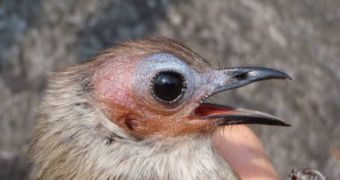In a new study they have conducted in the central regions of Laos, scientists have discovered a rare species of songbirds, which appears to be completely bald. Its head is completely feather-free, and the bird represents, according to researchers, the only type of bald songbird in Asia, and the first one to be reported in the past 100 years. Its unusual head has brought it the name of “bare-faced bulbul,” which is somewhat appropriate when you look at it. Naturalists are in awe as to how this peculiar bird has managed to escape detection for so long, as very little is known about it.
One possible explanation, they say, could be the fact that the creature prefers living in areas with little to no human presence, such as central Laos, where the landscape is dominated by rocky, limestone hills and mountains. Very few individuals venture in the wilderness, but the region is home to a variety of weird animals, including new species of rabbits and rats, discovered within the last decade. The first hints of the new creature were noted in 1995, when Wildlife Conservation Society (WCS) biologist Robert J. Timmins first saw what appeared to be a bald bird.
Despite writing about it in his notebook, the expert did not publish an account of it as, at the time, the idea of a bald bulbul seemed too far-fetched, Wired reports. “RJT subsequently weathered a fair amount of good-natured ribbing on relating the sighting to skeptical colleagues,” the researchers that finally introduced the new bird say in a paper published in the July issue of the journal Forktail. “Bald songbirds are unusual in general, not only in Asia. While in some birds, such as the vultures, it probably evolved as a feature that enabled more efficient feeding, in many species it is more likely that baldness evolved as a means of display,” WCS conservation biologist Peter Clyne adds.
The Pycnonotus hualon, the official name that the species has, has finally vindicated Timmins in the eyes of his colleagues more than 13 years after the original discovery. Two researchers have recently managed to spot the small, gray bird, which sports an orange, albeit featherless face, and a distinctive song. Using Timmins' original notes, they have succeeded in attracting six exemplaries to their location and capture one for taxonomic analysis. Back in the lab, it has been proven to indicate that the bird is a new species altogether.

 14 DAY TRIAL //
14 DAY TRIAL //